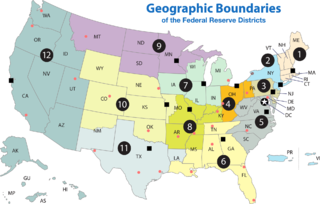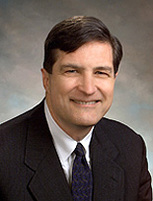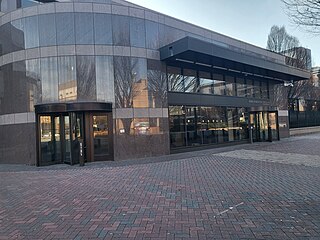
The Federal Reserve System is the central banking system of the United States. It was created on December 23, 1913, with the enactment of the Federal Reserve Act, after a series of financial panics led to the desire for central control of the monetary system in order to alleviate financial crises. Over the years, events such as the Great Depression in the 1930s and the Great Recession during the 2000s have led to the expansion of the roles and responsibilities of the Federal Reserve System.

The monetary policy of The United States is the set of policies which the Federal Reserve follows to achieve its twin objectives of high employment and stable inflation.

A Federal Reserve Bank is a regional bank of the Federal Reserve System, the central banking system of the United States. There are twelve in total, one for each of the twelve Federal Reserve Districts that were created by the Federal Reserve Act of 1913. The banks are jointly responsible for implementing the monetary policy set forth by the Federal Open Market Committee, and are divided as follows:

The Federal Reserve Bank of San Francisco is the federal bank for the twelfth district in the United States. The twelfth district is made up of nine western states—Alaska, Arizona, California, Hawaii, Idaho, Nevada, Oregon, Utah, and Washington—plus the Northern Mariana Islands, American Samoa, and Guam. The San Francisco Fed has branch offices in Los Angeles, Portland, Salt Lake City, and Seattle. It also has a cash processing center in Phoenix.

The Federal Reserve Bank of Boston, commonly known as the Boston Fed, is responsible for the First District of the Federal Reserve, which covers New England: Maine, Massachusetts, New Hampshire, Rhode Island, Vermont and all of Connecticut except Fairfield County. The code of the Bank is A1, meaning that dollar bills from this Bank will have the letter A on them. The Boston Fed describes its mission as promoting "growth and financial stability in New England and the nation". The Boston Fed also includes the New England Public Policy Center.

The Federal Reserve Bank of Kansas City is located in Kansas City, Missouri and covers the 10th District of the Federal Reserve, which includes Colorado, Kansas, Nebraska, Oklahoma, Wyoming, and portions of western Missouri and northern New Mexico. It is second only to the Federal Reserve Bank of San Francisco in size of geographic area served. Missouri is the only state with two main Federal Reserve Banks; the other is located in St. Louis.

The Federal Reserve Bank of St. Louis is one of 12 regional Reserve Banks that, along with the Board of Governors in Washington, D.C., make up the United States' central bank. Missouri is the only state to have two main Federal Reserve Banks.

The Federal Reserve Bank of Cleveland is the Cleveland-based headquarters of the U.S. Federal Reserve System's Fourth District. The district is composed of Ohio, western Pennsylvania, eastern Kentucky, and the northern panhandle of West Virginia. It has branch offices in Cincinnati and Pittsburgh. The check processing center in Columbus, Ohio, was closed in 2005. The chief executive officer and president is Loretta Mester.

The Federal Reserve Bank of Dallas covers the Eleventh Federal Reserve District of the United States, which includes Texas, northern Louisiana and southern New Mexico, a district sometimes referred to as the Oil Patch. The Federal Reserve Bank of Dallas is one of 12 regional Reserve Banks that, along with the Board of Governors in Washington, D.C., make up the U.S. central bank. The Dallas Fed is the only one where all external branches reside in the same state . The Dallas Fed has branch offices in El Paso, Houston, and San Antonio. The Dallas bank is located at 2200 Pearl St. in the Uptown neighborhood of Oak Lawn, just north of downtown Dallas and the Dallas Arts District. Prior to 1992, the bank was located at 400 S. Akard Street, in the Government District in Downtown Dallas. The older Dallas Fed building, which opened in 1921, was built in the Beaux-arts style, with large limestone structure with massive carved eagles and additional significant detailing; it is a City of Dallas Designated Landmark structure. The current Dallas Fed building, opened in September 1992, was designed by three architectural firms: Kohn Pedersen Fox Associates, New York; Sikes Jennings Kelly & Brewer, Houston; and John S. Chase, FAIA, Dallas and Houston, Dallas-based Austin Commercial Inc. served as project manager and general contractor.

The Federal Reserve Bank of Richmond is the headquarters of the Fifth District of the Federal Reserve located in Richmond, Virginia. It covers the District of Columbia, Maryland, North Carolina, South Carolina, Virginia, and most of West Virginia excluding the Northern Panhandle. Branch offices are located in Baltimore, Maryland and Charlotte, North Carolina. Thomas I. Barkin became president of the Richmond Fed following the retirement of Jeffrey M. Lacker in April 2017. The previous president, J. Alfred Broaddus, retired in 2004.

The Federal Reserve Bank of Chicago is one of twelve Federal Reserve Banks that, along with the Federal Reserve Board of Governors, make up the Federal Reserve System, the United States' central bank. The Chicago Fed serves the Seventh District, which encompasses the northern portions of Illinois and Indiana, southern Wisconsin, the Lower Peninsula of Michigan, and the state of Iowa. In addition to participation in the formulation of monetary policy, each Reserve Bank supervises member banks and bank holding companies, provides financial services to depository institutions and the U.S. government, and monitors economic conditions in its District.

The Federal Reserve Bank of Atlanta,, is the sixth district of the 12 Federal Reserve Banks of the United States and is headquartered in midtown Atlanta, Georgia.
The National Fed Challenge is an academic competition that provides high school students with an insider's view of how the United States central bank, the Federal Reserve, makes monetary policy.

Jeffrey M. Lacker is an American economist and was president of the Federal Reserve Bank of Richmond until April 4, 2017. He was a Distinguished Professor in the Department of Economics at the Virginia Commonwealth University School of Business in Richmond, Virginia.

The College National Fed Challenge is an annual team competition for undergraduate college students inspired by the working of the Federal Open Market Committee. The competition is intended to encourage students to learn more about the U.S. macro economy, the Federal Reserve System and the implementation of monetary policy. The College Fed Challenge also aims at promoting interest in economics and finance as subjects for advanced study and as the basis for a career.
The Federal Reserve Bank of Cleveland Pittsburgh Branch Office is one of two Federal Reserve Bank of Cleveland branch offices. The Pittsburgh Office of the Federal Reserve Bank of Cleveland hosts one of two savings bonds processing sites in the nation. The Pittsburgh branch presides over Jefferson, Monroe and Belmont counties in Ohio, Wetzel, Tyler, Pleasants, Marshall, Ohio, Brooke and Hancock counties in West Virginia, and all of Western Pennsylvania. In 1915 it was revealed that the Pittsburgh branch location was to be the new home of a relocated Cleveland Fed District with a majority vote secured on the board of governors, but the U.S. Attorney General at the time nixed moving the Cleveland, Kansas City, Minneapolis, Boston and Atlanta Federal Reserve Districts, stating that it would instead take an act of Congress to move those district headquarters. Pittsburgh remained a branch location only.

The Federal Reserve Bank of Richmond Charlotte Branch Office is one of the two Federal Reserve Bank of Richmond branch offices. Established in 1927, The Federal Reserve Bank of Richmond's Charlotte Branch is an operational and regional center for the Carolinas, including the nation's second largest financial center in Charlotte, North Carolina. They promote the safety and soundness of large bank holding companies headquartered in Charlotte. They distribute currency and coin to financial institutions in our region and provide check adjustment services for the Federal Reserve System. Their public programs include forums and conferences, economic education outreach, tours and a speakers’ bureau.
The Federal Reserve Bank of Chicago Detroit Branch Office is the only branch office of the Federal Reserve Bank of Chicago. It is part of the 7th district and its code is 7-G. It is currently located at 1600 East Warren Avenue, near I-75 in Detroit's Eastern Market Historic District. The office occupies 17 acres (6.9 ha) and cost $80 million to build. The Detroit branch was founded in 1927 and is currently headed by Robert Wiley. Each branch of the Federal Reserve Banks has a board of either seven or five directors, a majority of whom are appointed by the parent Federal Reserve Bank; the others are appointed by the Board of Governors. Branch directors serve staggered three-year terms. One of the members appointed by the Federal Reserve Board is designated annually as chairman of the board of that Branch in a manner prescribed by the parent Federal Reserve Bank.

The Structure of the Federal Reserve System is unique among central banks in the world, with both public and private aspects. It is described as "independent within the government" rather than "independent of government".














